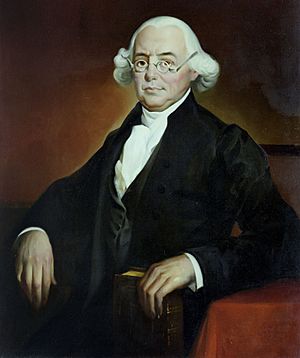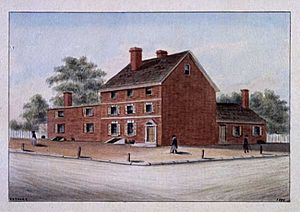James Wilson (Founding Father) facts for kids
Quick facts for kids
James Wilson
|
|
|---|---|
 |
|
| Associate Justice of the Supreme Court of the United States | |
| In office October 5, 1789 – August 21, 1798 |
|
| Nominated by | George Washington |
| Preceded by | Seat established |
| Succeeded by | Bushrod Washington |
| Personal details | |
| Born | September 14, 1742 Carskerdo Farm, Fife, Scotland, Great Britain |
| Died | August 21, 1798 (aged 55) Edenton, North Carolina, U.S. |
| Political party | Federalist |
| Spouses | Rachel Bird (1771–1786) Hannah Gray (1793–1798) |
| Education | University of St Andrews University of Glasgow University of Edinburgh |
| Signature | |
James Wilson (born September 14, 1742 – died August 21, 1798) was an important American leader, lawyer, and one of the Founding Fathers of the United States. He played a big part in creating the United States. He helped write the United States Declaration of Independence and was a major person involved in writing the Constitution of the United States.
Wilson was also one of the first six judges appointed by George Washington to the Supreme Court of the United States. He served as an associate justice from 1789 until his death in 1798. He was also the first law professor at the University of Pennsylvania, where he taught about the new Constitution.
Contents
Early Life and Learning Years
James Wilson was born on September 14, 1742, in Carskerdo, near Ceres, Fife, Scotland. He was one of seven children in a farming family. He went to the universities of St Andrews, Glasgow, and Edinburgh, but he didn't finish a degree. While studying, he learned from famous Scottish thinkers like Adam Smith.
In 1765, Wilson moved to Philadelphia, Pennsylvania, in America. He started working as a teacher at the College of Philadelphia. A few months later, he received an honorary Master of Arts degree from the college.
Wilson then began to study law with a lawyer named John Dickinson. In 1767, he became a lawyer in Philadelphia and started his own practice in Reading, Pennsylvania. His law office was very successful, and he earned a good amount of money. He also became a founding trustee of Dickinson College. In 1771, he married Rachel Bird, and they had six children. After Rachel passed away in 1786, he married Hannah Gray in 1793.
Fighting for American Independence
In 1774, James Wilson wrote an important paper called "Considerations on the Nature and Extent of the Legislative Authority of the British Parliament." In it, he argued that the British Parliament had no right to make laws for the American colonies. This was because the colonies had no representatives in Parliament. He believed that all power should come from the people.
In 1775, Wilson became a colonel in the Pennsylvania State Militia. He later became a brigadier general.
As a member of the Continental Congress in 1776, Wilson strongly supported American independence. He believed it was his job to follow the wishes of the people he represented. He waited for feedback from his district before voting for independence. While in Congress, he also helped shape America's policy with France and with Native American tribes.
In 1779, a group of angry people marched to Wilson's home in Philadelphia. This event became known as the Fort Wilson Riot. Wilson and about 35 friends barricaded themselves inside his house. Fighting broke out, and some people were hurt. Soldiers eventually arrived and rescued Wilson and his friends.
Wilson also became involved in buying and selling large amounts of land. He was the president of the Illinois-Wabash Company, which dealt with land. During the war, he also worked as a lawyer for France in America.
Helping to Create the Constitution
James Wilson was one of the most important lawyers of his time. He was also one of the most knowledgeable people at the Constitutional Convention in 1787. He spoke 168 times, more than almost anyone else.
Wilson believed in giving more power to the people. He wanted a strong national government and for states to have representatives based on their population. He strongly supported the House of Representatives, where members are directly elected by the people. He also wanted senators to be directly elected and for the president to be chosen by a national popular vote.
Wilson was against slavery, even though he owned one enslaved person himself. He believed the Constitution would eventually help end slavery in the country. However, to get the new Constitution approved, he helped create the Three-fifths Compromise. This rule counted three-fifths of a state's enslaved population towards its total population. This was used to decide how many representatives each state would have in the House of Representatives. Wilson later disagreed with this compromise.
Designing the President's Role
Many scholars say Wilson was the "main architect of the executive branch." He helped design the role of the president. He wanted a single president who would be strong, independent, and responsible to the people. At first, some people worried that a single leader might lead to a king. But Wilson argued that one leader would be more accountable and make decisions quickly, especially in emergencies. His idea for a single president was eventually accepted.
One of the hardest parts of the Convention was deciding how to choose the president. Wilson wanted the president to be elected directly by the people through a national popular vote. He believed this would make the president answerable to the public. When this idea didn't get enough support, he suggested using an electoral college. This system would have voters choose electors who would then vote for the president.
The idea of the Electoral College, similar to Wilson's proposal, was eventually adopted. It was a compromise that helped bring together different ideas from the states.
Working on the First Draft
Wilson had a big impact as a member of the Committee of Detail. This committee wrote the first draft of the United States Constitution. He wanted senators and the president to be elected by the people. He was very good at understanding how government and money worked together.
After the Convention, Wilson worked hard to get the Constitution approved. His speech on October 6, 1787, known as the "speech in the statehouse yard," was very important. It helped explain why a new national government elected by the people was a good idea. This speech was printed in newspapers across the country and helped gain support for the Constitution.
Wilson also played a key role in writing the 1790 Pennsylvania Constitution.
Serving on the Supreme Court
After the Constitution was approved, James Wilson wanted to be the first chief justice of the Supreme Court. However, President Washington chose John Jay for that role. Instead, on September 24, 1789, Washington nominated Wilson to be an associate justice of the Supreme Court. He was confirmed by the Senate and started his job on October 5, 1789.
Wilson and the other early judges spent most of their time traveling to different courts around the country. The Supreme Court heard only nine cases during his time there. One important case was Chisholm v. Georgia (1793), which said that federal courts could hear disagreements between private citizens and states.
During his last two years on the court, Wilson faced financial difficulties. He traveled in the South to avoid people he owed money to. He continued his duties as a judge. In 1798, he became sick and then died from a stroke at age 55. He was the first U.S. Supreme Court justice to die.
Teaching Law at the College of Philadelphia
In 1790, James Wilson became the first law professor at the College of Philadelphia. This was only the second time a law professor had been appointed at an American university. Wilson focused on the academic study of law, seeing it as part of a general education.
He stopped his law lectures to attend to his duties as a Supreme Court justice. His lectures were later published after his death. Today, the University of Pennsylvania Law School traces its beginnings to Wilson's lectures.
See also
 In Spanish: James Wilson (político) para niños
In Spanish: James Wilson (político) para niños



